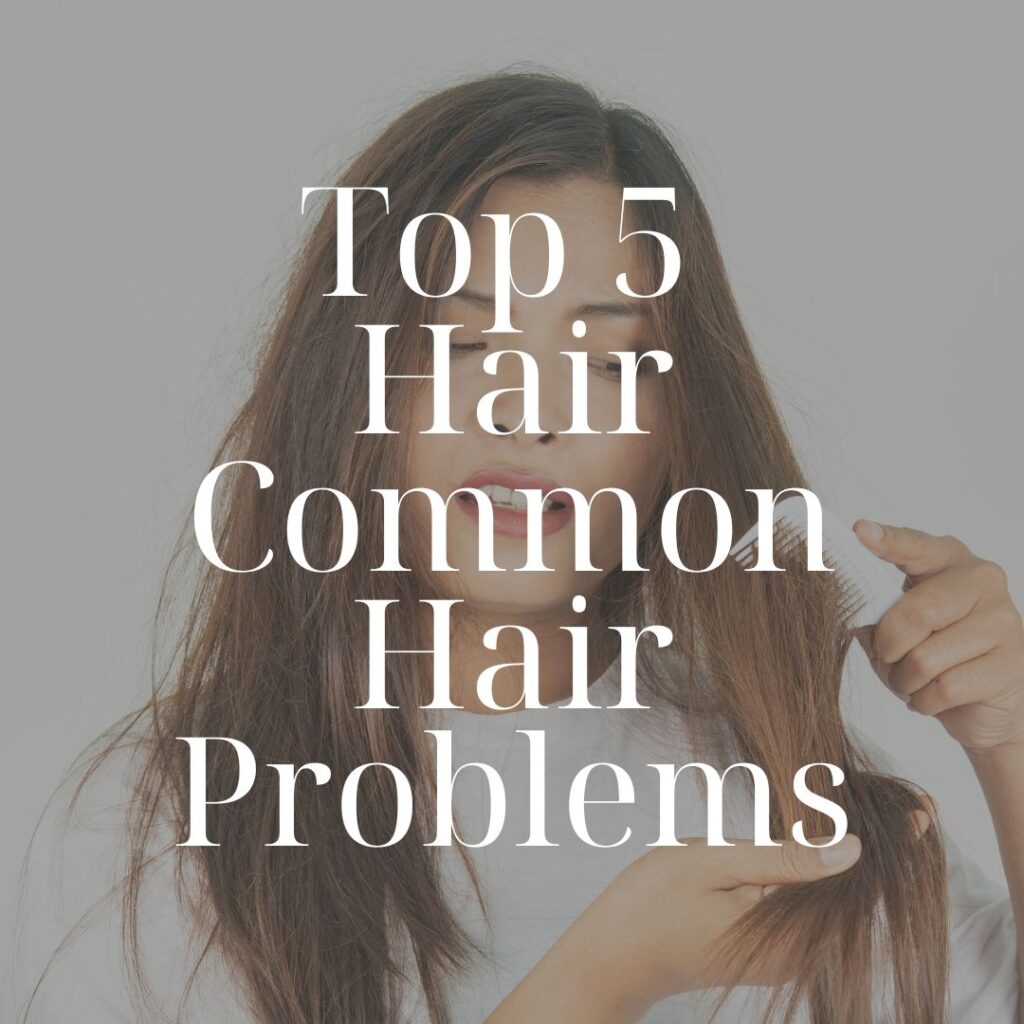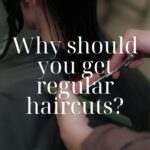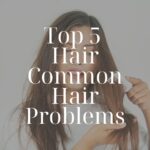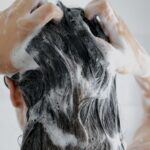Hair is often considered a person’s crowning glory, but it can also be a source of frustration when problems arise. From split ends to dandruff, there are a variety of issues that can affect the health and appearance of our locks. However, the good news is that many common hair problems can be addressed with the right knowledge and care. In this comprehensive guide, we’ll explore some of the most common hair problems and provide practical solutions to help you achieve healthier, more beautiful hair.
1. Split Ends
Split ends are a frequent complaint among many individuals, caused by damage to the hair shaft. This damage can result from various factors, including heat styling, chemical treatments, and environmental stressors. Split ends are usually one of the most popular hair problems due to the many factors such as – exposure to damage, hair structure, and moisture content in hair.
Symptoms: Split ends typically appear as the hair shaft splits into two or more strands at the ends. You may notice that the ends of your hair look frayed or have a “Y” shape, indicating the split. It may also be more prone to tangled ends with dryness or frizziness.
Solutions:
- Regular trims: It is essential to remove the damaged hair.
- Moisturise: Deep conditioning treatments are your best friend. Look for products with ingredients like shea butter, coconut oil, and hyaluronic acid.
- Minimising heat styling: Heat styling plays a huge role in many of the issues faced when trying to maintain a healthy and shiny hair health. Reduce the use of heat styling and turn to more natural styling habits instead!
Pro Tip
Reduce washing frequency to 2-3 times a week and use lukewarm water. Opt for a gentle, sulfate-free shampoo.
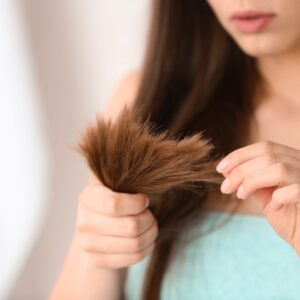
2. Dry and Brittle Hair
Dry and brittle hair is a prevalent hair problem that arises from a combination of internal and external factors affecting the hair’s health and moisture balance. One primary cause of dryness and brittleness is the depletion of natural oils and moisture from the hair shaft, which can occur due to overwashing with harsh shampoos, exposure to environmental stressors like sun, wind, and pollution, and frequent use of heat styling tools. Additionally, chemical treatments such as coloring, bleaching, and perming can strip the hair of its protective lipid layer, leading to moisture loss and weakening of the hair structure. Furthermore, nutritional deficiencies, dehydration, hormonal imbalances, and certain medications can impact the hair’s vitality and resilience, contributing to dryness and brittleness.
Symptoms: Hair feels coarse, lacks shine, and is prone to breakage and split ends.
Causes: Over-washing, harsh shampoos, excessive heat styling, sun exposure, chemical treatments (coloring, perming), and nutritional deficiencies.
Solutions:
- Hydration is Key: Limit washing frequency (aim for 2-3 times a week) and use a gentle, hydrating shampoo and conditioner. Look for formulas with ingredients like hyaluronic acid, argan oil, and shea butter.
- Deep Conditioning: Treat your hair to a deep conditioning mask once a week for an extra moisture boost.
- Heat Protectant is Your Friend: Never underestimate the power of a heat protectant spray before using hot tools like blow dryers, straighteners, or curling irons.
- Embrace Natural Drying: Whenever possible, let your hair air dry to minimize heat damage.
- Diet Matters: Ensure your diet is rich in essential vitamins and minerals like biotin, iron, and omega-3 fatty acids, which contribute to hair health.
3. Frizzy Hair
Frizzy hair is a common hair problem due to several factors affecting the hair’s structure and environment. One primary cause of frizz is the hair’s natural texture and porosity, particularly in individuals with curly or wavy hair types. The uneven distribution of natural oils along the hair shaft can lead to dehydration, making the hair more susceptible to frizz. Environmental factors such as humidity and temperature fluctuations play a significant role in exacerbating frizz by causing the hair cuticle to swell and lift, allowing moisture to penetrate and disrupt the hair’s smooth surface. Additionally, damage from heat styling tools, chemical treatments, and rough handling can further compromise the hair’s integrity, leading to frizz and flyaways.
Symptoms: Hair appears fluffy, unmanageable, and prone to static, especially in humid environments.
Causes: Dryness, damage, high porosity (hair absorbs moisture easily but loses it quickly), and chemical treatments.
Solutions:
- Hydration is Key (Again!): Follow the same hydration tips mentioned for dry hair. Deep conditioning is crucial for frizzy hair.
- Tame the Mane: Use anti-frizz serums or leave-in conditioners to smooth the hair cuticle and reduce frizz.
- Embrace the Microfiber Towel: Swap your regular towel for a microfiber towel to gently remove excess water without roughing up the hair cuticle.
- Diffuser is Your Friend: If you must use a blow dryer, opt for a diffuser attachment to distribute heat evenly and minimize frizz.
- Argan Oil Texture Control Treatment: Have you ever heard of our speciality? – Argan Oil Texture Control Treatment. It is our best rated treatment in treating frizz and repairing your hair cuticles with zero ammonia!
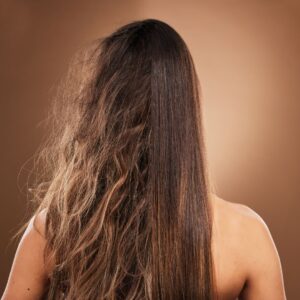
4. Dandruff
Dandruff is a common hair problem that occurs due to a combination of factors, including an overgrowth of a yeast-like fungus called Malassezia, irregular shedding of dead skin cells from the scalp, and sensitivity to certain hair care products. Malassezia naturally resides on the scalp and feeds on sebum, the oily substance produced by the skin’s sebaceous glands. However, when there is an overproduction of sebum or an imbalance in the scalp’s microbiome, Malassezia can proliferate, leading to irritation and inflammation. This triggers an accelerated shedding of skin cells, resulting in the characteristic flaking associated with dandruff. Additionally, factors such as stress, hormonal changes, environmental conditions, and poor hygiene practices can exacerbate dandruff symptoms.
Symptoms: Visible white flakes on the scalp and hair, often accompanied by itching.
Causes: Dry scalp, seborrheic dermatitis (a chronic skin condition), fungal infection (malassezia), and sensitivity to hair products.
Solutions:
- Anti-Dandruff Shampoo: Use a medicated anti-dandruff shampoo containing ingredients like zinc pyrithione, salicylic acid, or selenium sulfide. Follow the usage instructions carefully to avoid irritation.
- Scalp Soothing: Apply natural oils like tea tree oil or jojoba oil to the scalp to reduce inflammation and itching. (Important Note: Always dilute essential oils with a carrier oil like coconut oil before applying them to your scalp.)
- Identify Triggers: If your dandruff seems to worsen with certain hair products, identify and eliminate those triggers.
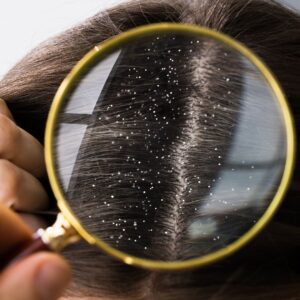
5. Hair Loss
Hair loss is a common hair problem influenced by various genetic, hormonal, environmental, and lifestyle factors. Genetic predisposition plays a significant role in pattern baldness, known as androgenetic alopecia, which affects both men and women and is characterized by progressive hair thinning and eventual hair loss. Hormonal imbalances, such as fluctuations in testosterone, estrogen, and thyroid hormones, can also contribute to hair loss by disrupting the hair growth cycle. Environmental factors, including exposure to pollutants, UV radiation, and harsh chemicals in hair care products, can damage the hair follicles and accelerate hair shedding. Additionally, lifestyle factors such as stress, poor nutrition, insufficient sleep, and certain medications or medical conditions can impact the hair’s health and vitality, leading to increased shedding and thinning. Without proper diagnosis and management, hair loss can worsen over time, affecting self-esteem and quality of life. Seeking professional guidance from dermatologists or trichologists can help identify the underlying causes and implement appropriate treatments to address hair loss effectively.
Symptoms: Thinning hair, excessive hair shedding, and noticeable bald patches.
Causes: Stress, genetics, hormonal changes (pregnancy, menopause), medical conditions (thyroid issues), scalp conditions (alopecia), and tight hairstyles.
Solutions:
- Consult a Dermatologist: Hair loss can be a symptom of an underlying medical condition. Consulting a dermatologist for diagnosis and treatment is crucial.
- Gentle Hair Care: Be gentle with your hair to minimize breakage. Avoid tight hairstyles, harsh chemicals, and excessive heat styling.
- Scalp Treatment: Customisable scalp treatment is available with De Arte Hair to help improve and strengthen your scalp to aid in hair growth. Remember, a little goes a long way! Treatments have to always be revisited in order to see improvement over time and investing in yourself is always worth it!
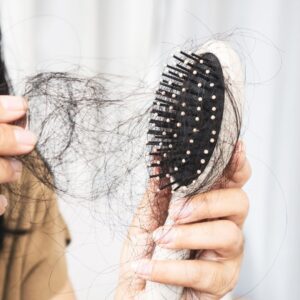
Combating Hair Problems
While experiencing hair problems can be frustrating, there are numerous solutions available to address common issues and promote healthier, more beautiful hair. By understanding the causes of these problems and implementing appropriate care routines, you can effectively manage and prevent many hair-related concerns. Remember to be patient and consistent with your hair care regimen, as achieving optimal results may take time. With the right knowledge and dedication, you can overcome common hair problems and enjoy luscious locks that shine with vitality and health.

